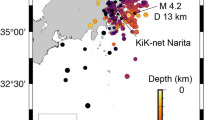Abstract
In recent years, sparker source has gradually been applied for high-resolution seismic surveys. But the air gun is still the most commonly used seismic sources in marine seismic exploration. The seismic data frequency range of the air gun sources is below 200 Hz. On the contrary, the seismic data frequency range of the sparker sources is about 50–500 Hz. The low and high frequency components of the seismic data are both important for high resolution seismic exploration. Usually the energy produced by the air gun sources is stronger than that of the sparker sources, so the exploration depth of the air gun sources is bigger than that of the sparker sources. How to make full use of the two kinds of source to carry out high-resolution seismic exploration is a particularly meaningful work. Here the combined processing idea of the two kinds of sources’ towed streamer seismic data were presented and we designed a complete data processing workflow. The amplitude matching of air gun and sparker source seismic data is a very key technique in this combined processing. The main processing steps include conventional processing such as noise attenuation, amplitude compensation, wavelet processing, velocity analysis, pre-stack time migration and so on. But also, there are some special processing techniques such as the residual static corrections, CDP trim statics corrections and post-stack predictive deconvolution which are applied to the sparker source data. The results show that the migration section of the combined processing is better than those of the separately processing.























Similar content being viewed by others
References
Cahyaningtyas MB (2018) Broadband seismic: case study modeling and data processing. IOP Conference Series Earth and Environmental Science, 132(1), 012001
Canales, L. L. (1984). Random noise reduction. In SEG Technical Program Expanded Abstracts 1984 (pp. 525-527). Society of Exploration Geophysicists.
Caporal M, Blacquière G, Davydenko M (2018) Broadband imaging via direct inversion of blended dispersed source array data. Geophys Prospect 66(5):942–953. https://doi.org/10.1111/1365-2478.12584
Dondurur D (2018) Acquisition and processing of marine seismic data. Elsevier
Duchesne MJ, Bellefleur G, Galbraith M, Kolesar R, Kuzmiski R (2007) Strategies for waveform processing in sparker data. Mar Geophys Res 28(2):153–164. https://doi.org/10.1007/s11001-007-9023-8
Elboth T, Presterud IV, Hermansen D (2010) Time-frequency seismic data de‐noising. Geophysical Prospecting, 58
Fulton TK (1985) Some interesting seismic noise. Leading Edge, 4
Gao X, Gong X, Gao S (2016) Scale factor estimation for OBC dual-sensor seismic data. Oil Geophys Prospect 51(1):49–53
Henriet J, Monjoie A, Schroeder C (1986) Shallow seismic investigations in engineering practice in Belgium. First Break, 4(5)
Herman M, Hashim HS, Latif AHA, Ghosh DP (2017) Application of FK Filtering for Coherent Noise Removal in High Frequency Shallow Marine Data. IOP Conference Series: Earth and Environmental Science
Hlebnikov, V., Elboth, T., Vinje, V., & Gelius, L. J. (2021). Noise types and their attenuation in towed marine seismic: A tutorial. Geophysics, 86(2), W1-W19.
Chen, K., & Sacchi, M. D. (2015). Robust reduced-rank filtering for erratic seismic noise attenuation. Geophysics, 80(1), V1-V11.
Kluesner J, Brothers D, Hart P, Miller N, Hatcher G (2018) Practical approaches to maximizing the resolution of sparker seismic reflection data. Marine Geophysical Research
Kong F, He T, Spence GD (2012) Application of deep-towed multichannel seismic system for gas hydrate on mid-slope of northern Cascadia margin. Sci China Earth Sci 55(5):758–769
Kragh E, Muyzert E, Curtis T, Svendsen M, Kapadia D (2010) Efficient broadband marine acquisition and processing for improved resolution and deep imaging. Lead Edge 29(4):464–469
Liu MY, Guo T, Shen MC, Dun-Shi WU, Shang-Wei WU, Yang N (2010) Using Multi-track Statistical Method for Extracting Wavelet and Its Application. Journal of Oil and Gas Technology
Luo G-C, Ge H-K, Wang B-S, Hu P, Mu H-W, Chen Y (2008) Fired Models of Air-gun Source and Its Application. Earthq Res China 22(2):112–120
Martin J (1999) Acquisition of marine point receiver seismic data with a towed streamer. SEG Tech Program Expanded Abstracts 19(1):2484
Parkes G (1986) The Marine Seismic Source. The Marine Seismic Source
Pascouet A (1991) Something new under the water: The bubbleless air gun. Lead Edge 10(11):79–81
Roeck D (1998) Very high resolution 3D marine seismic data processing for geotechnical applications. Geophys Prospect 46(2):105–120
Soubaras R (2011) Broadband Marine Seismic – Breaking the Limits
Vaezi Y, Kazemi N (2016) Attenuation of swell noise in marine streamer data via nonnegative matrix factorization. SEG Technical Program Expanded Abstracts 2016
Vassallo M, Eggenberger K, van Manen D-J, Özbek A, Watterson P (2013) Broadband and beyond with marine towed streamers. Lead Edge 32(11):1356–1365
Wang X, Qi B, Zhao Q, Wang W, Yu K (2019) Feasibility of sparker source in marine seismic exploration: data analysis and processing. Acta Geophys 67(5):1413–1418
Yilmaz Ö (2001) Seismic data analysis: Processing, inversion, and interpretation of seismic data. Society of exploration geophysicists
Zhao X, Lu P, Zhang Y, Chen J, Li X (2019) Swell-noise attenuation: A deep learning approach. Lead Edge 38(12):934–942
Acknowledgements
This research was funded by the National Natural Science Foundation of China (No. 41874131) and the National Key Research and Development Program of China (2017YFC0307405).
Author information
Authors and Affiliations
Corresponding author
Additional information
Publisher’s note
Springer Nature remains neutral with regard to jurisdictional claims in published maps and institutional affiliations.
Rights and permissions
About this article
Cite this article
Yang, Z., Wang, X., Hao, X. et al. Research on combined processing techniques of air gun and sparker source towed streamer seismic data. Mar Geophys Res 43, 18 (2022). https://doi.org/10.1007/s11001-022-09484-y
Received:
Revised:
Accepted:
Published:
DOI: https://doi.org/10.1007/s11001-022-09484-y




